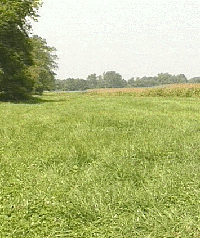Drought Has Varied Effect on Kentucky Pastures
Drought Has Varied Effect on Kentucky Pastures

The effect of the extended drought in Kentucky is very apparent in field crops, but the Commonwealth's pastureland may be a more variable story. Whether or not these pastures survive the drought will depend on such factors as the length of the drought, the types of forage plants used in those pastures and how heavily those crops are grazed.
"The real question during and toward the end of a drought is whether the plants are still alive, or did they expend too much energy or were too stressed during the drought and are now dead," said Jimmy Henning, Extension forage specialist in the University of Kentucky College of Agriculture.
Kentucky farmers use a large variety of grasses and legumes in their pastures and the drought and grazing pressure will probably hit each one differently.
"Alfalfa will go into a dormant state and will generally not be hurt very much by hot, dry weather. It will bloom while very short, and can be grazed off without hurting the stand," said Henning.
Red clover crops are not expected to fair as well as alfalfa. Red clover does not like drought during the seedling stage. Hot, dry summers will shorten the stand life of red clover. The net effect is that red clover plants will die after the second season of growth. Improved varieties will show better persistence and yield more than common types, but they suffer from the drought as well.
It may still be a wait and see process for stands of Timothy grass. "This grass tends to be hurt by droughts and stands can be thinned," said Henning. "However, Timothy in hay fields that have been left idle due to little or no growth will be less stressed than pastures." On the other hand Orchard grass is a strong perennial, and unless severely over- grazed, will come through the drought. Close clipping or overgrazing will deplete energy stores as well as allowing the crown to get hot and that scenario would damage Orchard grass.
Endophyte-infected tall fescue can be expected to survive the drought, while endophyte-free fescues are more negatively affected and, in severe cases, may die.
‘The presence of the endophyte in tall fescue gives it more drought tolerance, so this is one time where the endophyte is clearly beneficial at least to the plant," said Henning .
Georgia farmers planted their first round of endophyte-free tall fescue varieties in the mid-1980s and experienced some severe droughts soon after that effort. University of Georgia plant scientists found that where fescue was closely grazed (roughly 1.5 to 2 inches), fields with endophyte-free varieties died. When grass height was left higher (about 3 to 4 inches), the fields lived.
"Right now, three to four inches of pasture seems like it is almost enough to make hay. But the point is that if you have a field of endophyte free fescue, it is the last place that you want to really over graze," said Henning.
(30)
